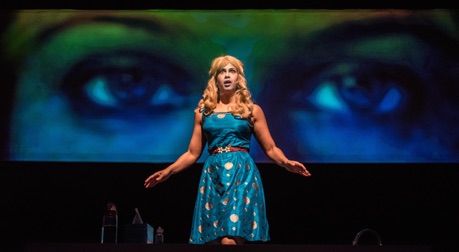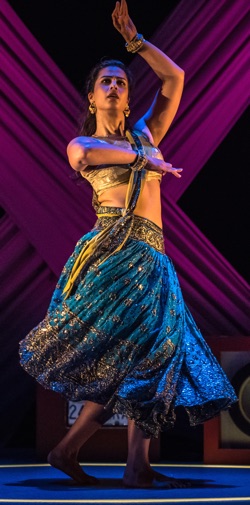Reviews 2017






✭✭✭✩✩ / ✭✭✭✩✩ / ✭✭✭✭✩
by Anita Majumdar, directed by Brian Quirt
Nightswimming, Factory Theatre Mainspace, Toronto
September 28-October 15, 2017
“Slumdog Millionaire songs for white people weddings”
In 2005 Anita Majumdar premiered a wonderful one-act play called Fish Eyes that combined her well-honed skills in acting as well as classical Indian dance. It portrayed the struggle of Meena, a Port Moody, BC, high school girl, torn between her Indian heritage and and the pressure to conform in the mostly white school she attends. In 2015 Majumdar wrote another play, Boys With Cars, about a Muslim girl at school with Meena, caught in the same struggle, but who experienced crushing humiliation. In 2015 Majumdar wrote a third play, Let Me Borrow That Top, about the same school, this time focussing on a white girl, both envied and despised by the girls of the previous two plays.
Now for the first time in Toronto Majumdar presents all three one-act plays together under the title of The Fish Eyes Trilogy. It is a tour de force of acting and dancing for Majumdar, who carries the entire two-and-a-half-hour-long show on her own shoulders. But it is also clear that neither Boys With Cars nor Let Me Borrow That Top are plays as engaging as Fish Eyes.
Structurally, the trilogy is intriguing. The three plays together present three points of view on a single event that takes place at an assembly in the gym of the Port Moody Senior Secondary School, or PMSSS as Nazneen, the girl in Boys With Cars, jokingly calls it. One Phys. Ed. class is divided into groups and each group is to devise a dance presentation, the best of which is performed at a special school assembly. The winning dance has been choreographed by Meena, the only trained dancer in the group, which includes high school alpha female Candice, who had decided the group should use an Indian theme. Meanwhile, Nazneen, who also studies classical Indian dance but is not in Meena’s Phys. Ed. class, watches from the bleachers with Candice’s boyfriend Buddy, who forces her to perform a lewd act during the performance. The fallout from this one dance event is different for all three girls although themes of male oppression and cultural appropriation appear in all three.
Majumdar has decided to present the trilogy with Boys With Cars and Let Me Borrow That Top presented first before intermission with Fish Eyes presented as the concluding play even though the action of all three intersect. Majumdar likely begins with Boys With Cars because it covers the longest time period, one extending both before and after the dance at the assembly. Of the play’s six characters, all played by Majumdar, we first meet Nazneen, called Naz for short, who is standing by a car parked near the PMSSS and fuming for several reasons. First, she has to dance at the wedding of the school’s two coolest kids, Buddy and Candice, who happen to be white. Buddy is the one who forced Naz to give him a handjob during the assembly, then told Candice about it causing her to spread malicious rumours about Naz throughout the school. Given all this, Majumdar provides no credible explanation why Naz would agree to perform for such people at their wedding.
Another reason Naz is angry is that her boyfriend Lucky Punjabi has not shown up. He went away to a bhangra competition and has not come back. In a very confusing section, Majumdar shows how Lucky may have heard of Naz’s disgrace at school and that that is why he has not returned, but it is unclear whether this is true or imagined. We also hear in a rush of plot developments that Naz’s parents are so ashamed of Naz that they have gone to Dubai and have left her with a guardian and that somehow her disgrace has also prevented her from attending UBC. Up until this point Boys With Cars has moved at a quick but steady pace, but Majumdar concludes with a barrage of new information meant to show how our society punishes the victim in sexual assault cases. Unfortunately, without telling us exactly how Naz loses her boyfriend, parents and university position all due to rumours spread about her, Majumdar’s story becomes hyperbolic rather than convincing.

Let Me Borrow That Top, the weakest of the three plays, focusses on the white girl Candice. The play is in the form of one of Candice’s daily vlogs, this one about her beauty regimen made months before she marries Buddy. The theme of the play is cultural appropriation and the cleverest aspect of it is seeing Majumdar transform herself before our eyes into the blond, blue-eyed Candice by use of a wig, contact lenses and makeup. Majumdar thus appropriates Candice’s colour and background all the while that Candice is speaking of how she has been so turned on to Indian dance by Meena (of Fish Eyes) that she has applied to enter the Coventry School of Bhangra in England.
Majumdar presents Candice as a stereotypical dumb blonde who expresses herself in the upspeak and vocal fry of California Valley Girls. The most amusing part of the play is Candice’s demonstration of her abilities at classical Indian dance where she sacrifices all the grace of arm and body movement that we saw earlier with Naz for a kind of cheerleader-like athleticism. The problem is that the very unrefinement of Candice’s dancing, makes her acceptance by the British school incomprehensible.
The way information is presented in Let Me Borrow That Top suffers the same way as in the conclusion of Boys With Cars. Initially, we are led to think that Candice simply goes off-topic when speaking about her personal life. But Majumdar also has Candice act out what must be flashbacks, such as her trip to Coventry to show off her supposed skill in dance, It soon becomes confusing which aspects of the past are meant to be in the vlog and which are not.
When we move on to Fish Eyes after the interval, we see that it is still the gem of a play that it was in 2005. Dance and storytelling are better integrated than they are in the the first two plays and Fish Eyes tells a more nuanced story rather than one that seems to have been invented to decry already much decried practices such as blaming the victim or cultural appropriation.

In Fish Eyes both Meena and Kalyania Aunty are warm, multifaceted characters. Meena's inner struggle is shown outwardly by her idolization of Bollywood superstar Aishwarya Rai on the one hand, and her romantic fantasies about becoming the girlfriend of the white top jock at high school, Buddy, the villain of the previous two plays. Meena does not want to go to the prestigious competition in India because it conflicts with the graduation dance at high school where she imagines she will somehow win Buddy over. Her fantasy comes crashing down once she realizes that Buddy is already in love with the white girl Candice.
Kalyania Aunty is a wonderful character, who can’t bring herself to be as harsh with Meena as she would like. Majumdar acts the part with great sympathy and humour. Majumdar shows the older woman completely understands Meena’s emotional turmoil. As someone who grew up under the Raj, Kalyania Aunty herself imagined that a white British officer was in love with her, until she learned he was already married.
The Fish Eyes Trilogy is worth seeing simply to experience the play that gives the trilogy its name. The first two plays set up a context, but Fish Eyes is self-contained and stands up on its own. The first two plays allow Majumdar to explore male abuse of women and cultural appropriation more explicitly but not as successfully as they are dealt with in Fish Eyes.
When the trilogy was first presented at the PuSh International Performing Arts Festival in Vancouver in 2015, separate admission was charged for Fish Eyes and for the pairing of Boys With Cars with Let Me Borrow That Top. Theatre-goers could combine the two parts as a package and could see Fish Eyes either as the beginning or the ending of the trilogy. Since the plays present a synoptic view of the same event, this seems like a wiser way to present them. It would be a shame if the prospect of seeing the whole trilogy at once prevented anyone from seeing so talented a performer as Majumdar especially in Fish Eyes.
©Christopher Hoile
Note: This review is a Stage Door exclusive.
Photos: (from top) Anita Majumdar as Nazneen; as Candice; and as Meena. ©2017 Dahlia Katz.
For tickets, visit www.factorytheatre.ca.
2017-10-04



The Fish Eyes Trilogy: Boys With Cars / Let Me Borrow That Top / Fish Eyes





